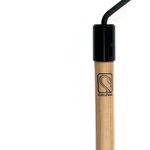
It’s just plain HOT! There’s no sugarcoating the heat in the desert right now. If you’re like us, you head outside only in the early morning and late evening if you can help it. Just the thought of gardening in midday right now makes us squirm.

Plant a tree: palo verde. One tree that truly loves the heat is palo verde (Parkinsonia spp. and cvs., Zones 9–11). The two most common species in the Southwest are blue palo verde (Parkinsonia florida, Zones 8–10) and yellow or foothills palo verde (Parkinsonia microphylla, Zones 9–10), the former being the state tree of Arizona. With their vibrant yellow blooms and their ability to thrive without supplemental water once established, these trees are beautiful additions to any Southwestern landscape. They are very low maintenance and can grow between 20 and 30 feet tall. Palo verdes can be planted in the warmer months because they love the desert heat, but be sure to give unestablished trees a deep watering this month—and watch out for huge palo verde beetles (Derobrachus geminatus) while you are watering! Leave those palo verde branches alone until the winter months. No pruning until then.

Watch out for grasshoppers. Grasshoppers can be extremely invasive, so keep an eye on your plant leaves. If you find that you have a grasshopper problem, use an organic deterrent to keep them at bay. We recommend blending 2 cups of garlic with 10 cups of water. Boil the mixture down a bit, and let it sit overnight. You can then take this solution and mix it with more water. Mix about three times as much cold water as solution, and then pour this new solution into a spray bottle. Spritz this all over the affected plants and leaves to help keep those pesky grasshoppers away.

Prune and deadhead. If you’re feeling brave on one of our cooler days, you can absolutely do some summertime pruning in the month of August. Examine your perennials. If they look leggy and overgrown, cut them back by one-third. Be sure to deadhead those summer-flowering shrubs to keep the color alive in your yard. You can also prune your pride of Barbados (Caesalpinia pulcherrima, Zones 9–11) and oleander (Nerium oleander, Zones 8–10) to clean them up a bit and help them maintain their shape. This will also promote more blooms.

Hose off your plants every week. Sometimes we’re so mindful of the soil that we forget that those leaves love a good shower too. Not only does this promote a healthy plant, but it also helps wash away any potential spider mites and dust. This video gives more information on controlling spider mites if you have them. We were always taught not to water the leaves during the day, as it can cause them to burn in the midday sun. That has been proven false, and watering the leaves can actually help cool plants down. We still learn new things all the time!

Plant a perennial: silver spurge. Our perennial focus this month is silver spurge (Euphorbia rigida, Zones 7–10), which is hardy to 0°F. Considered a weed in some parts of the world, this unique plant gets a serious thumbs-up from us. It’s drought tolerant, boasts beautiful yellow and green blooms in the spring, and sprawls into unique formations, giving it a very cool look. The silver-gray leaves against the vibrant flowers bring so much depth and interest to this seemingly simple plant. Whether you plant it in a garden bed, rock garden, or container, this spurge is sure to be a winner. Infrequent waterings will keep it happy, and if you need to prune, be sure to throw on a pair of gloves. As with other spurges, silver spurge contains sap that can be a skin irritant. For more information on this plant and other stellar spurges, read here. Enjoy your gardens this August, and stay cool out there!
—Sheila Schultz and Laurel Startzel are a mother-daughter duo who founded Denver Dirty Girls Container Gardening while living in Denver and have continued their business since moving to Tucson, Arizona.
Fine Gardening Recommended Products

RAINPOINT Sprinkler Timer with Brass Swivel
Fine Gardening receives a commission for items purchased through links on this site, including Amazon Associates and other affiliate advertising programs.
- Built-in metal filter gaskets can prevent sediment and other larger particles
- Through the Sprinkler Timer program, you can set the start time, watering duration, and watering frequency

CobraHead® Long Handle Weeder & Cultivator Garden Tool
Fine Gardening receives a commission for items purchased through links on this site, including Amazon Associates and other affiliate advertising programs.

Water Right PSH-100-MG-1PKRS 400 Series, 100-Foot, Olive Green
Fine Gardening receives a commission for items purchased through links on this site, including Amazon Associates and other affiliate advertising programs.
- 3 Pounds
- 1200"L x 0.43"W
- Manufactured in the USA



















Comments
Log in or create an account to post a comment.
Sign up Log in